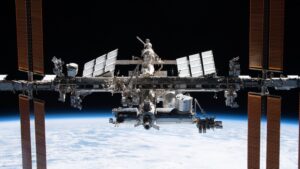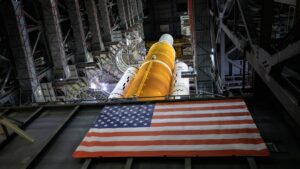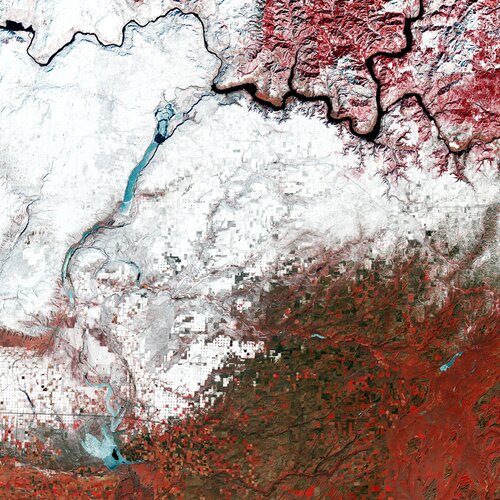ESA to continue cooperation but monitoring situation following Russia’s invasion of Ukraine
Friday, 25 February 2022 11:51
ESA is continuing work on the International Space Station and ExoMars programs in the wake of Russia’s invasion of Ukraine but monitoring the situation, the agency’s Director-General said Friday.
The post ESA to continue cooperation but monitoring situation following Russia’s invasion of Ukraine appeared first on SpaceNews.
NASA to roll out SLS in mid-March for launch rehearsal
Friday, 25 February 2022 11:34
NASA expects to roll out the Space Launch System rocket for the first time in mid-March for a dress rehearsal of a launch that could come as soon as May but more likely some time in the summer.
Pentagon and Partners Release Combined Space Operations Vision 2031
Friday, 25 February 2022 09:50 The United States joins Australia, Canada, France, Germany, New Zealand, and the United Kingdom in the joint release of the "Combined Space Operations (CSpO) Vision 2031" today.
CSpO is an initiative to address the overarching need to encourage responsible use of space, recognizing challenges to space sustainability, threats presented by technological advances, and the increasingly compreh
The United States joins Australia, Canada, France, Germany, New Zealand, and the United Kingdom in the joint release of the "Combined Space Operations (CSpO) Vision 2031" today.
CSpO is an initiative to address the overarching need to encourage responsible use of space, recognizing challenges to space sustainability, threats presented by technological advances, and the increasingly compreh Space Micro lands Space Development Agency contract for optical communications
Friday, 25 February 2022 09:50 Voyager Space and Space Micro has announced an award from the Space Development Agency (SDA) for a 24-month development contract for advanced one-to-many optical communications using Managed Optical Communication Array (MOCA) technology to support Low Earth Orbit (LEO) constellations. Space Micro partnered with BridgeComm Inc., a global leader in optical wireless communications solutions and ser
Voyager Space and Space Micro has announced an award from the Space Development Agency (SDA) for a 24-month development contract for advanced one-to-many optical communications using Managed Optical Communication Array (MOCA) technology to support Low Earth Orbit (LEO) constellations. Space Micro partnered with BridgeComm Inc., a global leader in optical wireless communications solutions and ser The last day of the dinosaurs
Friday, 25 February 2022 09:50 The asteroid which killed nearly all of the dinosaurs struck Earth during springtime. This conclusion was drawn by an international team of researchers after having examined thin sections, high-resolution synchrotron X-ray scans, and carbon isotope records of the bones of fishes that died less than 60 minutes after the asteroid impacted. The team presents its findings in the journal Nature.
The asteroid which killed nearly all of the dinosaurs struck Earth during springtime. This conclusion was drawn by an international team of researchers after having examined thin sections, high-resolution synchrotron X-ray scans, and carbon isotope records of the bones of fishes that died less than 60 minutes after the asteroid impacted. The team presents its findings in the journal Nature. Potential widespread effects of geoengineering on both climate and the carbon cycle
Friday, 25 February 2022 09:50 Global warming poses a great threat to our society, and it will continue unless a deep and rapid reduction in greenhouse gas emissions is implemented. One alternative way to counteract some of the undesired effects of global warming is geoengineering, also referred to as solar radiation modification, or climate engineering.
The basic idea of geoengineering is to cool the earth by intention
Global warming poses a great threat to our society, and it will continue unless a deep and rapid reduction in greenhouse gas emissions is implemented. One alternative way to counteract some of the undesired effects of global warming is geoengineering, also referred to as solar radiation modification, or climate engineering.
The basic idea of geoengineering is to cool the earth by intention Ball Aerospace supports CDR of NASA's SPHEREx mission
Friday, 25 February 2022 09:50 Ball Aerospace supported completion of critical design review (CDR) for NASA's Spectro-Photometer for the History of the Universe, Epoch of Reionization and Ices Explorer (SPHEREx) mission. Ball will now move forward with building the telescope and spacecraft.
In addition to designing and building the spacecraft and telescope, Ball Aerospace is responsible for conducting system integration
Ball Aerospace supported completion of critical design review (CDR) for NASA's Spectro-Photometer for the History of the Universe, Epoch of Reionization and Ices Explorer (SPHEREx) mission. Ball will now move forward with building the telescope and spacecraft.
In addition to designing and building the spacecraft and telescope, Ball Aerospace is responsible for conducting system integration Cosmic flashes pinpointed to a surprising location in space
Friday, 25 February 2022 09:50 Astronomers have been surprised by the closest source of the mysterious flashes in the sky known as fast radio bursts. Precision measurements with radio telescopes reveal that the bursts are made among old stars, and in a way that no one was expecting. The source of the flashes, in nearby spiral galaxy M 81, is the closest of its kind to Earth.?
Fast radio bursts are unpredictable, extreme
Astronomers have been surprised by the closest source of the mysterious flashes in the sky known as fast radio bursts. Precision measurements with radio telescopes reveal that the bursts are made among old stars, and in a way that no one was expecting. The source of the flashes, in nearby spiral galaxy M 81, is the closest of its kind to Earth.?
Fast radio bursts are unpredictable, extreme Earth from Space: Washington, US
Friday, 25 February 2022 08:00
To celebrate the recent data release from Landsat 9, this week we take a closer look at a part of Washington state – the northwesternmost state of the US – through the lens of Landsat 9.
Rocket Lab Selected by MDA to Design and Build Spacecraft for Globalstar
Friday, 25 February 2022 05:59 Rocket Lab USA has been awarded a subcontract by MDA Ltd to lead the design and manufacture of 17 spacecraft buses for Globalstar's new Low Earth Orbit satellites. Globalstar, Inc. Rocket Lab will lead the development of the spacecraft buses, while MDA will act as prime contractor to manufacture Globalstar's satellites, lead the development of the payload, and perform the final satellite assembl
Rocket Lab USA has been awarded a subcontract by MDA Ltd to lead the design and manufacture of 17 spacecraft buses for Globalstar's new Low Earth Orbit satellites. Globalstar, Inc. Rocket Lab will lead the development of the spacecraft buses, while MDA will act as prime contractor to manufacture Globalstar's satellites, lead the development of the payload, and perform the final satellite assembl Intelsat announces successful emergence from financial restructuring process
Friday, 25 February 2022 05:59 Intelsat S.A. has successfully completed and emerged from its financial restructuring process as a private company with a substantially strengthened capital structure to support its growth as the leader in satellite communications. This final milestone follows receipt of regulatory approvals, completion of certain corporate actions, and satisfaction of other customary conditions.
Intelsat'
Intelsat S.A. has successfully completed and emerged from its financial restructuring process as a private company with a substantially strengthened capital structure to support its growth as the leader in satellite communications. This final milestone follows receipt of regulatory approvals, completion of certain corporate actions, and satisfaction of other customary conditions.
Intelsat' PPM partners with Aston Uni to develop game-changing satcom technology
Friday, 25 February 2022 05:59 Pulse Power and Measurement Ltd (PPM) has been working with Aston University through a Knowledge Transfer Partnership (KTP) to develop a game-changing approach to technology used in the radio-over-fibre communications industry. The project will look to transform the connection between low earth orbit (LEO) satellite antenna dishes and modems through optics rather than electronics, delivering per
Pulse Power and Measurement Ltd (PPM) has been working with Aston University through a Knowledge Transfer Partnership (KTP) to develop a game-changing approach to technology used in the radio-over-fibre communications industry. The project will look to transform the connection between low earth orbit (LEO) satellite antenna dishes and modems through optics rather than electronics, delivering per Dusty Flight 19 completed and looking ahead to Flight 20
Friday, 25 February 2022 05:59 Flight 19 was successfully completed on February 7, 2022, at 20:21 PST (Sol 345 of the Perseverance mission, 12:00 LMST Local Mean Solar Time), and placed Ingenuity safely within the designated landing ellipse just above the eastern ridge of the "South Seitah" basin. Flight 19 was a reminder of the challenges and unpredictability of the Martian environment.
As discussed in our previous upd
Flight 19 was successfully completed on February 7, 2022, at 20:21 PST (Sol 345 of the Perseverance mission, 12:00 LMST Local Mean Solar Time), and placed Ingenuity safely within the designated landing ellipse just above the eastern ridge of the "South Seitah" basin. Flight 19 was a reminder of the challenges and unpredictability of the Martian environment.
As discussed in our previous upd NASA plans mid-March test for SLS moon rocket's first flight
Friday, 25 February 2022 05:59 NASA officials said Thursday the space agency is making progress toward a crucial test in mid-March of the first moon rocket since the Apollo-era but the agency did not set a new launch date for the first lunar mission.
NASA plans the full "wet-dress rehearsal" of the SLS moon rocket on the pad at 6 p.m. ET on March 17.
The first such mission to the moon, although uncrewed, may h
NASA officials said Thursday the space agency is making progress toward a crucial test in mid-March of the first moon rocket since the Apollo-era but the agency did not set a new launch date for the first lunar mission.
NASA plans the full "wet-dress rehearsal" of the SLS moon rocket on the pad at 6 p.m. ET on March 17.
The first such mission to the moon, although uncrewed, may h HSE University researchers discover what happens on the bright side of the moon
Friday, 25 February 2022 05:59 Researchers from HSE University have developed a mathematical model that explains the levitation of charged dust particles over the sunlit lunar surface for almost any latitude. For the first time, the model takes into account the Earth's magnetotail-a particular area around our planet. The research data is important for planning the Luna-25 and Luna-27 space missions. The study was published in
Researchers from HSE University have developed a mathematical model that explains the levitation of charged dust particles over the sunlit lunar surface for almost any latitude. For the first time, the model takes into account the Earth's magnetotail-a particular area around our planet. The research data is important for planning the Luna-25 and Luna-27 space missions. The study was published in 
